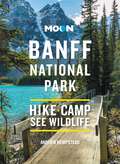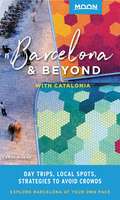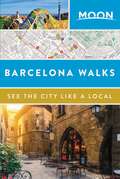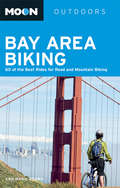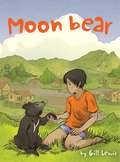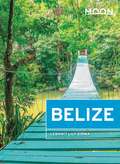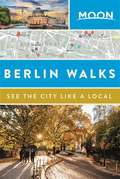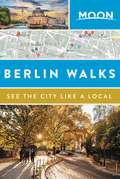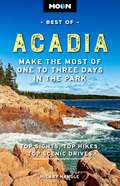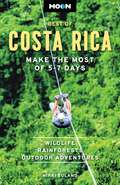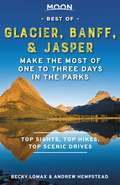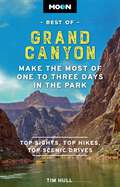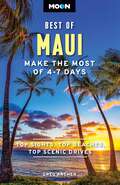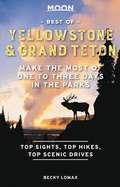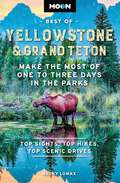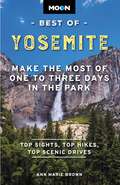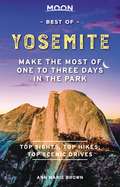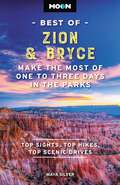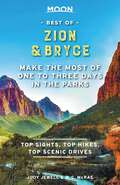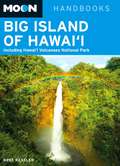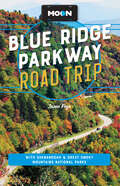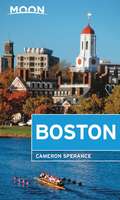- Table View
- List View
Moon Banff National Park: Scenic Drives, Wildlife, Hiking & Skiing (Travel Guide)
by Andrew HempsteadBanff sparkles as the crown jewel of Canada's national parks. Explore the best of it with Moon Banff National Park. Inside you'll find:Strategic, flexible itineraries, including the Best of Banff and highlights for a day trip The Best Hikes in Banff: Find the right trek for you with details on length, elevation gains, difficulty levels, and trailheads Experience the Outdoors: Ride over the snow in a horse-drawn sleigh or through the sky in a mountain gondola. Follow the vast network of hiking trails along glacial valleys and discover alpine lakes and spectacular vistas. Soak in a natural hot spring, treat yourself at a luxurious mountain resort, or discover the park's history at one of Banff's excellent museums. Grab a cup of coffee at a local shop, or experience the town's classic après-ski nightlife How to Get There: Up-to-date information on gateway towns, park entrances, park fees, and tours Where to Stay: From campgrounds and rustic lodges to sprawling ski resorts, find the best spots to kick back, both inside and outside the park Planning Tips: When to go, what to pack, safety information, and how to avoid the crowds, with full-color photos and detailed maps throughoutExpertise and Know-How from seasoned explorer and Banff local Andrew Hempstead Find your adventure in Banff National Park with Moon. Exploring more of Canada's great outdoors? Try Moon Canadian Rockies. Hitting the road? Try Moon Vancouver & Canadian Rockies Road Trip. About Moon Travel Guides: Moon was founded in 1973 to empower independent, active, and conscious travel. We prioritize local businesses, outdoor recreation, and traveling strategically and sustainably. Moon Travel Guides are written by local, expert authors with great stories to tell—and they can't wait to share their favorite places with you. For more inspiration, follow @moonguides on social media.
Moon Barcelona & Beyond: Day Trips, Local Spots, Strategies to Avoid Crowds (Travel Guide)
by Carol MoranWhether you're marveling at Gaudi masterpieces or cheering with locals at a fútbol match, soak up the best of Catalonia's sun, sea, and delicious flavors with Moon Barcelona & Beyond.Explore In and Around the City: Get to know Barcelona's most interesting neighborhoods, like the Gothic Quarter, El Born, the Ciutat Vella, and Gràcia, and nearby regions, including Girona, Sitges, and moreGo at Your Own Pace: Choose from tons of itinerary options designed for foodies, beach-goers, history buffs, art lovers, and moreSee the Sights: Marvel at the Sagrada Familia's fantastical architecture, hike through the colorful Parc Güell, see Picasso's earliest-known drawings, and stroll the narrow streets of the Barri Gòtic Get Outside the City: Savor cava in the Penedès wine region, swim in the sparkling water on the Costa Brava, explore the medieval village of Besalú, or climb to the Sant Jeroni peak in MontserratSavor the Flavors: Feast on a seafood paella, sample your way through a bustling market, and find the best spots for authentic tapasExperience the Nightlife: Sip sangria on the beach, discover a local favorite cocktail bar, people-watch from a bustling terrace, and enjoy regional Catalan winesGet to Know the Real Barcelona: Follow suggestions from Barcelona transplant Carol Moran for supporting indie businesses and avoiding crowdsFull-Color Photos and Detailed MapsHandy Tools: Background information on Catalan and Basque history and culture, plus tips on ethical travel, what to pack, where to stay, and how to get aroundDay trip itineraries, favorite local spots, and strategies to skip the crowds: Take your time with Moon Barcelona & Beyond.Exploring more of Europe? Check out Moon Venice & Beyond or Moon Lisbon & Beyond.
Moon Barcelona Walks (Travel Guide)
by Moon Travel GuidesExperience Barcelona like a local: on foot! Wander "Barça's" ancient alleys and beachfront boulevards, savor the sunshine and sangria, and discover the city's hip hot spots and bohemian hangouts with Moon Barcelona Walks. This full-color guide features:Six customizable walks through the city's liveliest neighborhoods, including El Born, Gràcia, Barceloneta, the Gothic Quarter, and more, with color-coded stops and turn-by-turn directions; Foldout maps of each route and a removable full-city map in a handy, portable guide; Curated "Top Ten" lists for architecture, restaurants, Sunday activities, and nightlife, for visitors looking to hit the highlights; The top attractions and the best-kept local secrets: Browse designer boutiques and pop in to a trendy coffee shop, or stroll the beaches of Barceloneta to bask in the culture of an authentic fishing neighborhood. Marvel at the Sagrada Familia, or admire gothic architecture as you stroll the medieval streets of the historic barri. Walk through an old Olympic village, wander through Park Güell, and see the famed works of Picasso and Gaudi. Sip sangria by the beach, sample classic and modern tapas, and discover the hippest bars and clubs for a night on the town; Public transportation options, including the metro, bus, or bike rental; Tips for first-time visitors, including national holidays, where you'll need to make a reservation, and getting to and from the airport; With creative routes, public transit options, and a full-city map, you can explore Barcelona at your own pace, without missing a beat.
Moon Bay Area Biking: More Than 60 of the Best Rides for Road and Mountain Biking (Moon Outdoors)
by Ann Marie BrownCovering the most popular Bay Area biking destinations—as well as some well-kept secrets—this is the biker's guide to finding the best rides throughout the region. Moon Bay Area Biking guides bikers through the North, East, and South Bay, as well as surrounding areas, with rides alongside the Pacific Coast and through lush state parks. Brown outlines a wide variety of roads and trails, including family-friendly rides, paths good for wildlife viewing, and routes full of history. Complete with elevation charts, route maps, options to extend or shorten each ride, plus information on bike shops, riding clubs, and bike organizations throughout the Bay Area, Moon Bay Area Biking gives bicyclists the tools they need to create a more personal and memorable experience.
Moon Bear
by Gill Lewis Alessandro GottardoBoth torn from their homes in Laos, a boy and a moon bear cub form a deep bond in this piercing tale of impossible odds and resilient hope, based on true conditions in Eastern Asia.Twelve-year-old Tam, on a dare, ventures into a moon bear den in the mountains of Northern Laos. His goal is to steal the cub and sell it, making a fortune for his family. But the mother bear's unexpected return upends Tam's plan, and he barely escapes with his life. And then his life implodes anyway: his entire mountain village is forced to relocate to make room for a new highway. Lured by the promise of electricity, running water, and a television, Tam's people move to an overcrowded village, where Tam's father is killed by a stray landmine. Now the family breadwinner, Tam is forced to work hundreds of miles away in the city, at a moon bear farm where bile from bear gall bladders is used for medicine. It is a cruel, miserable place, and when a familiar face--the very cub he'd seen in the den--is sold to the bear farm, Tam knows he must save this moon bear, no matter what it takes. He secretly nurses it back to health and they develop an unbreakable bond. Tam swears to return his beloved cub to the wild, but how will they ever find a way to be free? Deeply and powerfully moving, Moon Bear is an unforgettable story of compassion, hope, and bravery against overwhelming odds, and brings to light the real-life, heartwrenching plight of Asia's endangered moon bears.
Moon Belize: Including Ambergris Caye & Caye Caulker (Travel Guide)
by Lebawit Lily GirmaWith turquoise waters, dreamlike islands, and pristine rainforests, Belize is a sensory feast. Dive in with Moon Belize. Inside you'll find:Flexible itineraries, from the weeklong best of Belize to three weeks exploring the whole country Strategic advice for water sports lovers, foodies, wildlife enthusiasts, and more, plus suggestions for supporting local businesses and exploring ethically and sustainablyThe top outdoor adventures: Hike rainforests filled with medicinal trees and howler monkeys, snorkel the second-largest coral reef in the world, go spelunking in ancient underground caves, or hop through the vibrant cayesUnique experiences and can't-miss highlights: Canoe to a farmers market to sample fresh pupusas and cashew wine, and cool off beneath the waterfalls. Marvel at Mayan archaeological sites or experience a traditional homestay in Punta Gorda. Relax on the beach all day, and spend your night dancing barefoot in the sand to the sound of Garifuna drumsHonest advice on when to go, what to pack, and where to stay, from Belize expert Lebawit Lily GirmaFull-color photos and detailed maps throughoutEssential background on the landscape, climate, wildlife, and culture, plus handy phrases in Kriol, Garifuna, and Q'eqchi' MayanHelpful recommendations for health and safety, traveling solo, and suggestions for LGBTQ visitors, travelers with disabilities, and seniorsExperience the best of Belize with Moon's expert tips and local insight.Looking to expand your trip? Try Moon Yucatán Peninsula or Moon Costa Rica.
Moon Berlin Walks
by Moon Travel GuidesExperience Berlin like a local: on foot! Moon Berlin Walks reveals Berlin's thriving art scene, palpable history, and unique vibe by guiding you to the city's unmissable hotspots and trendiest locales. This full-color guide features: Six customizable walks through the city's hippest neighborhoods, including Kreuzberg, Prenzlauer Berg, Shöneberg, and more, with color-coded stops and turn-by-turn directions; Foldout maps of each route and a removable full-city map, in a handy, portable guide; Curated "Top Ten" lists for restaurants, street food, nightlife, and Sunday activities for visitors looking to hit the highlights; The top attractions and the best-kept local secrets: Stumble upon the newest, hippest coffee shop in Prenzlauer, or kick back in a popular public park. Discover your favorite currywurst or kebap stand, or sample schnitzel, spätzle, and brews at a biergarten. Peruse vintage knick-knacks at a Sunday flea market, and admire the works of art along the East Side Gallery. Browse world-class museums, or head to historical sites like Checkpoint Charlie. Dance the night away to an up-and-coming DJ set in an open-air club or underground warehouse party, or sip craft cocktails at a brand-new rooftop bar overlooking the city. Public transportation options, including the subway, bus, taxi, or bike rental. Tips for first-time visitors, including navigating nightlife, where you'll need to make a reservation, and getting to and from the airport. With creative routes, public transit options, and a full-city map, you can explore Berlin at your own pace, without missing a beat.
Moon Berlin Walks (Travel Guide)
by Moon Travel GuidesExperience Berlin like a local: on foot!Moon Berlin Walks reveals Berlin's thriving art scene, palpable history, and unique vibe by guiding you to the city's unmissable hotspots and trendiest locales. This full-color guide features:Six customizable walks through the city's hippest neighborhoods, including Kreuzberg, Prenzlauer Berg, Shöneberg, and more, with color-coded stops and turn-by-turn directionsFoldout maps of each route and a removable full-city map, in a handy, portable guideCurated "Top Ten" lists for restaurants, street food, nightlife, and Sunday activities for visitors looking to hit the highlightsThe top attractions and the best-kept local secrets: Stumble upon the newest, hippest coffee shop in Prenzlauer, or kick back in a popular public park. Discover your favorite currywurst or kebap stand, or sample schnitzel, spätzle, and brews at a biergarten. Peruse vintage knick-knacks at a Sunday flea market, and admire the works of art along the East Side Gallery. Browse world-class museums, or head to historical sites like Checkpoint Charlie. Dance the night away to an up-and-coming DJ set in an open-air club or underground warehouse party, or sip craft cocktails at a brand-new rooftop bar overlooking the cityPublic transportation options, including the subway, bus, taxi, or bike rentalTips for first-time visitors, including navigating nightlife, where you'll need to make a reservation, and getting to and from the airportWith creative routes, public transit options, and a full-city map, you can explore Berlin at your own pace, without missing a beat.Check out our guides to more of the world's liveliest cities, so you can hit the ground running! Also available: Moon Barcelona Walks, Moon New York Walks, Moon London Walks, Moon Amsterdam Walks, Moon Paris Walks, and Moon Rome Walks
Moon Bermuda (Travel Guide)
by Rosemary JonesImpossibly turquoise bays, pink sands, and hibiscus-scented breezes: go with the flow and experience a fantasy come to life with Moon Bermuda. Inside you'll find:Strategic itineraries designed for honeymooners, families, outdoor adventurers, history buffs, and moreUnique experiences and can't-miss highlights: Stroll the soft sands of Elbow Beach, dive to underwater shipwrecks, and splash around in the warm waves. Spend a morning browsing Hamilton's boutiques and historic churches, and stroll the colorful Bermuda Botanical Gardens. Spot ring-tailed lemurs, seahorses and sharks at the Bermuda Aquarium, Museum & Zoo, and visit the incredible formations of Crystal Cave. Watch the sun go down over the Harrington Sound as you dine al fresco on fresh seafood and cassava fries, and relax at a beachfront bar with a rum swizzleAdvice on outdoor activities, from golf to watersports, including scuba diving, snorkeling, waterskiing, wakeboarding, and flyboardingHonest recommendations from local Rosemary Jones on when to go, where to eat, how to get around, and where to stay, from waterfront cottages and luxurious resorts to budget hotelsFull-color photos and detailed maps throughoutPractical background on Bermuda's landscape, culture, history, and environmentHandy information for families, seniors, travelers with disabilities, LGBTQ+ travelers, and visitors planning a wedding, as well as volunteer opportunitiesWith Moon Bermuda's expert tips and local know-how, you can plan your trip your way.Island-hopping around the Caribbean? Try Moon Dominican Republic, Moon Aruba, or Moon Jamaica.
Moon Best of Acadia: Make the Most of One to Three Days in the Park (Travel Guide)
by Hilary NangleWhether you're visiting the park for a day hike or spending a long weekend under the stars, escape to the great outdoors with Moon Best of Acadia National Park. Inside you'll find:Easy itineraries for one to three days in Acadia National Park, from a morning drive along the Park Loop Road, to a day hike on Cadillac Mountain, to a full weekend exploring the park The top hikes in Acadia: Whether you're looking to stretch your legs for a couple hours or challenge yourself to a full day hike, you'll find trailheads, detailed trail descriptions, individual maps, mileage, and elevation gains Can't-miss experiences: Make it the perfect getaway with the best views, picnic spots, and more. Embark on a whale-watching excursion or hike along the secluded rocky shore of Isle de Haut. Sea kayak at sunset, take a leisurely bike ride through fiery fall foliage, or marvel at the tide roaring through Thunder Hole Stunning full-color photos and detailed maps throughout, plus a full-color foldout mapEssential planning tips: Find out when to go, where to stay, and what to pack, plus up-to-date information on entrance fees, reservations, and safety advice Expert insight from born-and-bred Mainer Hilary Nangle Make the most of your adventure with Moon Best of Acadia National Park. Planning a longer trip? Pick up Moon Maine. Visiting more of North America's incredible national parks? Try Moon USA National Parks.About Moon Travel Guides: Moon was founded in 1973 to empower independent, active, and conscious travel. We prioritize local businesses, outdoor recreation, and traveling strategically and sustainably. Moon Travel Guides are written by local, expert authors with great stories to tell—and they can't wait to share their favorite places with you. For more inspiration, follow @moonguides on social media.
Moon Best of Costa Rica: Make the Most of 5-7 Days (Travel Guide)
by Nikki SolanoFrom waterfalls and cloud forests to white sand beaches, a week of pura vida awaits with Moon Best of Costa Rica. Inside you&’ll find:Flexible, strategic itineraries: Choose the best home base for you with regional five-day itinerary options or combine shorter side trips for a week of exploring The top adventures: Discover the best wildlife and marine life experiences, waterfalls, beaches, rainforests and cloud forests, ziplines, surf spots, and more Authentic can&’t-miss experiences: Swim under a waterfall, raft over rapids, and explore mysterious caves. Admire the forest floor from the middle of a hanging bridge, take an aerial tram with incredible views, or snorkel with sea turtles in warm turquoise water. Relax on a pristine beach, soak in a volcanic mineral pool, and watch the sunrise with a cup of flavorful local coffee Insight from Cartago local Nikki Solano on how to experience Costa Rica like an insider, support local and sustainable businesses, avoid crowds, and respectfully engage with the culture Helpful charts with travel times from San Jose or Liberia international airports Full-color photos and detailed maps throughoutBackground information on Costa Rica's wildlife, landscape, history, and cultural customs, plus travel essentials like a packing list and health and safety information With Moon's selective coverage and strategic tips, you can experience the best of Costa Rica. Planning to stay more than a week? Check out Moon Costa Rica.About Moon Travel Guides: Moon was founded in 1973 to empower independent, active, and conscious travel. We prioritize local businesses, outdoor recreation, and traveling strategically and sustainably. Moon Travel Guides are written by local, expert authors with great stories to tell—and they can't wait to share their favorite places with you. For more inspiration, follow @moonguides on social media.
Moon Best of Glacier, Banff & Jasper: Make the Most of One to Three Days in the Parks (Travel Guide)
by Becky Lomax Andrew HempsteadWhether you're stopping for a day hike or spending a long weekend under the stars, escape to the great outdoors with Moon Best of Glacier, Banff & Jasper. Inside you'll find:Easy itineraries for one to three days in Glacier, Banff, and Jasper National Parks, from a scenic drive along Going-to-the-Sun Road, to a day of hiking through glacial valleys, to a weekend exploring the best of all three parks with mix-and-match itinerariesThe top hikes in Glacier, Banff, and Jasper: Whether you're looking to stretch your legs for a couple hours or challenge yourself to an epic trek, you'll find trailheads, detailed trail descriptions, individual maps, mileage, and elevation gainsCan't-miss experiences: Make it the perfect getaway for you with the best views, picnic spots, and more. Trek through fields of alpine wildflowers, walk beneath waterfalls, get your adrenaline pumping on the Glacier Skywalk, and spot wild moose or grizzlies roaming the mountainsideStunning full-color photos and maps throughout, plus a full-color foldout mapEssential planning tips: Find out when to go, where to stay, and what to pack, plus up-to-date information on entrance fees, border crossing, reservations, and safety adviceKnow-how from outdoors experts Andrew Hempstead and Becky LomaxMake the most of your adventure with Moon Best of Glacier, Banff & Jasper.Visiting more of North America's incredible national parks? Try Moon USA National Parks. About Moon Travel Guides: Moon was founded in 1973 to empower independent, active, and conscious travel. We prioritize local businesses, outdoor recreation, and traveling strategically and sustainably. Moon Travel Guides are written by local, expert authors with great stories to tell—and they can't wait to share their favorite places with you.For more inspiration, follow @moonguides on social media.
Moon Best of Glacier, Banff & Jasper: Make the Most of One to Three Days in the Parks (Travel Guide)
by Becky Lomax Andrew Hempstead Moon Travel GuidesWhether you're stopping for a day hike or spending a long weekend under the stars, escape to the great outdoors with Moon Best of Glacier, Banff & Jasper. Inside you'll find:Easy itineraries for one to four days in Glacier, Banff, and Jasper national parks, from a scenic drive along Going-to-the-Sun Road, to a day of hiking through glacial valleys, to a weekend exploring the best of all three parks with mix-and-match itinerariesThe top hikes in Glacier, Banff, and Jasper: Whether you're looking to stretch your legs for a couple hours or challenge yourself to an epic trek, you'll find trailheads, detailed trail descriptions, individual maps, mileage, and elevation gains Can't-miss experiences: Make it the perfect getaway for you with the best views, picnic spots, and more. Trek through fields of alpine wildflowers, walk beneath waterfalls, get your adrenaline pumping on the Glacier Skywalk, and spot wild moose or grizzlies roaming the mountainside Stunning full-color photos and maps throughout, plus a full-color foldout mapEssential planning tips: Find out when to go, where to stay, and what to pack, plus up-to-date information on entrance fees, border crossing, reservations, and safety advice Know-how from outdoors experts Andrew Hempstead and Becky LomaxMake the most of your adventure with Moon Best of Glacier, Banff & Jasper. Visiting more of North America's incredible national parks? Try Moon USA National Parks. Spending more time in Glacier? Try Moon Glacier National Park.About Moon Travel Guides: Moon was founded in 1973 to empower independent, active, and conscious travel. We prioritize local businesses, outdoor recreation, and traveling strategically and sustainably. Moon Travel Guides are written by local, expert authors with great stories to tell—and they can't wait to share their favorite places with you.
Moon Best of Grand Canyon: Make the Most of One to Three Days in the Park (Travel Guide)
by Tim HullWhether you're stopping for a day hike or spending a long weekend under the stars, escape to the great outdoors with Moon Best of Grand Canyon. Inside you'll find:Easy itineraries for one to three days in Grand Canyon National Park, from a morning bike ride along the South Rim, to a day hike in the inner canyon, to a full weekend exploring the park The top hikes in Grand Canyon: Whether you're looking to stretch your legs for a couple hours or challenge yourself to an epic trek, you'll find trailheads, detailed trail descriptions, individual maps, mileage, and elevation gains Can't-miss experiences: Make it the perfect getaway for you with the best views, scenic drives, picnic spots, and more. Trek into Havasu Canyon to see stunning waterfalls or drive to viewpoints along Hermit Road. Go on a rafting adventure on the Colorado River and spot wildlife like elk and bighorn sheep Stunning full-color photos and maps throughout, plus a full-color foldout mapEssential planning tips: Find out when to go, where to stay, and what to pack, plus up-to-date information on entrance fees, reservations, and safety advice Helpful resources on Covid-19 and visiting the Grand Canyon Know-how from Arizona local and Grand Canyon expert Tim HullMake the most of your adventure with Moon Best of Grand Canyon. Visiting more of North America's incredible national parks? Try Moon USA National Parks. About Moon Travel Guides: Moon was founded in 1973 to empower independent, active, and conscious travel. We prioritize local businesses, outdoor recreation, and traveling strategically and sustainably. Moon Travel Guides are written by local, expert authors with great stories to tell—and they can't wait to share their favorite places with you. For more inspiration, follow @moonguides on social media.
Moon Best of Maui: Make the Most of 4-7 Days (Moon U.S. Travel Guide)
by Greg Archer Moon Travel GuidesFrom endless golden beaches and legendary surf to epic outdoor adventures, a week in paradise awaits with advice from Hawaii insider Greg Archer. Inside Moon Best of Maui you&’ll find:Flexible, strategic itineraries: Spend 7 days seeing the best of Maui or follow short itinerary options for each region that can be combined for a longer trip Authentic can&’t-miss experiences: Enjoy the best beaches, diving and snorkeling spots, views, and more. Drive the famous 30-mile Road to Hana, bike through misty hidden valleys, and hike through bamboo forests to thundering waterfalls. Snorkel with giant green sea turtles, learn how to catch the perfect wave, or embark on a whale-watching tour. Savor Hawaiian cuisine, unwind at a luxurious spa, or relax on a beach as you watch the sunset Expert insight from Maui local Greg Archer on how to experience the island like an insider, support local and sustainable businesses, and avoid crowds Full-color photos and detailed maps throughoutBackground information on Maui&’s landscape, history, and culture With Moon's selective coverage and strategic tips, you can experience the best of Maui.About Moon Travel Guides: Moon was founded in 1973 to empower independent, active, and conscious travel. We prioritize local businesses, outdoor recreation, and traveling strategically and sustainably. Moon Travel Guides are written by local, expert authors with great stories to tell—and they can&’t wait to share their favorite places with you. For more inspiration, follow @moonguides on social media.
Moon Best of Yellowstone & Grand Teton: Make the Most of One to Three Days in the Parks (Travel Guide)
by Becky LomaxWhether you're stopping for a day hike or spending a long weekend under the stars, escape to the great outdoors with Moon Best of Yellowstone & Grand Teton. Inside you'll find:Easy itineraries for one to three days in Yellowstone and Grand Teton National Parks, from an afternoon sighting of Old Faithful, to a hike to Inspiration Point, to a weekend exploring both parks with mix-and-match itinerariesThe top hikes in Yellowstone and Grand Teton: Whether you're looking to stretch your legs for a couple hours or challenge yourself to an epic trek, you'll find trailheads, detailed trail descriptions, individual maps, mileage, and elevation gainsCan't-miss experiences: Make it the perfect getaway for you with the best lakes, views, picnic spots, and more. Hike through alpine forests to rushing waterfalls and panoramic lakeside views, or catch a glimpse of bison, elk, wolves, or bears. Take in the colorful radiance of Grand Prismatic Spring or stroll the boardwalks along Mammoth Hot SpringsStunning full-color photos and maps throughout, plus a full-color foldout mapEssential planning tips: Find out when to go, where to stay, and what to pack, plus up-to-date information on entrance fees, reservations, and safety adviceKnow-how from outdoors expert and former park ranger Becky LomaxMake the most of your adventure with Moon Best of Yellowstone & Grand Teton.Visiting more of North America's incredible national parks? Try Moon USA National Parks.
Moon Best of Yellowstone & Grand Teton: Make the Most of One to Three Days in the Parks (Travel Guide)
by Becky LomaxWhether you're stopping for a day hike or spending a long weekend under the stars, escape to the great outdoors with Moon Best of Yellowstone & Grand Teton. Inside you'll find:Easy itineraries for one to three days in Yellowstone and Grand Teton National Parks, from an afternoon sighting of Old Faithful, to a hike to Inspiration Point, to a weekend exploring both parks with mix-and-match itinerariesThe top hikes in Yellowstone and Grand Teton: Whether you're looking to stretch your legs for a couple hours or challenge yourself to an epic trek, you'll find trailheads, detailed trail descriptions, individual maps, mileage, and elevation gains Can't-miss experiences: Make it the perfect getaway with the best lakes, views, picnic spots, and more. Hike through alpine forests to rushing waterfalls and panoramic lakeside views, or catch a glimpse of wild bison, elk, wolves, or bears. Bask in the colorful radiance of Grand Prismatic Spring or stroll the boardwalks along Mammoth Hot Springs Stunning full-color photos and detailed maps throughout, plus a full-color foldout mapEssential planning tips: Find out when to go, where to stay, and what to pack, plus up-to-date information on entrance fees, reservations, and safety advice Know-how from outdoors expert and former park guide Becky LomaxMake the most of your adventure with Moon Best of Yellowstone & Grand Teton. Planning a longer trip? Pick up Moon Yellowstone & Grand Teton. Visiting more of North America's incredible national parks? Try Moon USA National Parks.About Moon Travel Guides: Moon was founded in 1973 to empower independent, active, and conscious travel. We prioritize local businesses, outdoor recreation, and traveling strategically and sustainably. Moon Travel Guides are written by local, expert authors with great stories to tell—and they can't wait to share their favorite places with you.
Moon Best of Yosemite: Make the Most of One to Three Days in the Park (Moon Best of Travel Guide)
by Ann Marie Brown Moon Travel GuidesWhether you're visiting the park for a day hike or spending a long weekend under the stars, escape to the great outdoors with Moon Best of Yosemite. Inside you'll find:Easy itineraries for one to three days in Yosemite National Park, from a morning drive along the Tioga Pass Road, to a day hike along the Panorama Trail, to a full weekend exploring the park The top hikes in Yosemite: Whether you're looking to stretch your legs for a couple hours or challenge yourself to an epic trek, you'll find trailheads, detailed trail descriptions, individual maps, mileage, and elevation gains Can't-miss experiences: Make it the perfect getaway for you with the best waterfalls, views, picnic spots, and more. Ride the open-air tram through Yosemite Valley or hike downhill from Glacier Point past roaring waterfalls. Admire the towering trees in the Mariposa Grove of Giant Sequoias, or spot black bears and bighorn sheep Stunning full-color photos and detailed maps throughout, plus a full-color foldout mapEssential planning tips: Find out when to go, where to stay, and what to pack, plus up-to-date information on entrance fees, reservations, and safety advice Know-how from outdoorswoman and Yosemite expert Ann Marie BrownMake the most of your adventure with Moon Best of Yosemite. Spending more time in the park or expanding your trip? Try Moon Yosemite, Sequoia & Kings Canyon. Visiting more of North America's incredible national parks? Try Moon USA National Parks.About Moon Travel Guides: Moon was founded in 1973 to empower independent, active, and conscious travel. We prioritize local businesses, outdoor recreation, and traveling strategically and sustainably. Moon Travel Guides are written by local, expert authors with great stories to tell—and they can't wait to share their favorite places with you. For more inspiration, follow @moonguides on social media.
Moon Best of Yosemite: Make the Most of One to Three Days in the Park (Travel Guide)
by Ann Marie BrownWhether you're visiting the park for a day hike or spending a long weekend under the stars, escape to the great outdoors with Moon Best of Yosemite. Inside you'll find:Easy itineraries for one to three days in Yosemite National Park, from a morning drive along the Tioga Pass Road, to a day hike along the Panorama Trail, to a full weekend exploring the parkThe top hikes in Yosemite: Whether you're looking to stretch your legs for a couple hours or challenge yourself to an epic trek, you'll find trailheads, detailed trail descriptions, individual maps, mileage, and elevation gainsCan't-miss experiences: Make it the perfect getaway for you with the best waterfalls, views, picnic spots, and more. Ride the open-air tram through Yosemite Valley or hike downhill from Glacier Point past roaring waterfalls. Admire the towering trees in the Mariposa Grove of Giant Sequoias, or spot black bears and bighorn sheepStunning full-color photos and maps throughout, plus a full-color foldout mapEssential planning tips: Find out when to go, where to stay, and what to pack, plus up-to-date information on entrance fees, reservations, and safety adviceKnow-how from outdoorswoman and Yosemite expert Ann Marie BrownMake the most of your adventure with Moon Best of Yosemite.Visiting more of North America's incredible national parks? Try Moon USA National Parks.
Moon Best of Zion & Bryce: Make the Most of One to Three Days in the Parks (Moon Best of Travel Guide)
by Moon Travel Guides Maya SilverWhether you're stopping for a day hike or spending a long weekend under the stars, escape to the great outdoors with Moon Best of Zion & Bryce. Inside you'll find:Easy itineraries for one to three days in Zion and Bryce Canyon National Parks, from a morning hike to Weeping Rock, to a day of river rafting, to a weekend exploring both parks with mix-and-match itinerariesThe top hikes in Zion & Bryce: Whether you're looking to stretch your legs for a couple hours or challenge yourself to an epic trek, you'll find trailheads, detailed trail descriptions, individual maps, mileage, and elevation gains Can't-miss experiences: Make it the perfect getaway for you with the best views, picnic spots, and more. Snap a pic on a sunrise hike or get your adrenaline pumping on a white-water rafting excursion down the Colorado River. Explore the beautiful remains of ancient Native American rock art throughout the parks and learn about the Indigenous culture of the area Stunning full-color photos and maps throughout, plus a full-color foldout mapEssential planning tips: Find out when to go, where to stay, and what to pack, plus up-to-date information on entrance fees, reservations, and safety advice Know-how from Zion and Bryce expert Maya SilverMake the most of your adventure with Moon Best of Zion & Bryce. Spending more time in the parks? Check out Moon Zion & Bryce.About Moon Travel Guides: Moon was founded in 1973 to empower independent, active, and conscious travel. We prioritize local businesses, outdoor recreation, and traveling strategically and sustainably. Moon Travel Guides are written by local, expert authors with great stories to tell—and they can't wait to share their favorite places with you.
Moon Best of Zion & Bryce: Make the Most of One to Three Days in the Parks (Travel Guide)
by Judy Jewell W. C. McRaeWhether you're stopping for a day hike or spending a long weekend under the stars, escape to the great outdoors with Moon Best of Zion & Bryce. Inside you'll find:Easy itineraries for one to three days in Zion and Bryce Canyon National Parks, from a morning hike to Weeping Rock, to a day of river rafting, to a weekend exploring both parks with mix-and-match itinerariesThe top hikes in Zion & Bryce: Whether you're looking to stretch your legs for a couple hours or challenge yourself to an epic trek, you'll find trailheads, detailed trail descriptions, individual maps, mileage, and elevation gainsCan't-miss experiences: Make it the perfect getaway for you with the best views, picnic spots, and more. Snap a pic on a sunrise hike or get your adrenaline pumping on a white-water rafting excursion down the Colorado River. Explore the beautiful remains of ancient Native American rock art throughout the parks and learn about the Indigenous culture of the areaStunning full-color photos and maps throughout, plus a full-color foldout mapEssential planning tips: Find out when to go, where to stay, and what to pack, plus up-to-date information on entrance fees, reservations, and safety adviceKnow-how from Zion and Bryce experts Judy Jewell and W.C. McRaeMake the most of your adventure with Moon Best of Zion & Bryce.Visiting more of North America's incredible national parks? Try Moon USA National Parks.
Moon Big Island of Hawai'i
by Bree KesslerHawai'i resident Bree Kessler covers the best sights and adventures that the Big Island has to offer, from soaking up the sun on Kona's iconic white sand beaches to sampling local delicacies at Hilo's popular farmer's market. Kessler also offers one-of-a-kind trip ideas, including Eat Your Way Around the Island, Big Island on a Budget, and Just Leave Me at the Beach-an itinerary for travelers who want to spend their entire vacation relaxing on the sand. Brimming with details on checking out the sea turtles at Punalu’u Beach County Park, tidepooling in Pahoa, and venturing up Saddle Road for the spectacular views at the Mauna Kea observatory,Moon Big Island of Hawai'igives travelers the tools they need to create a more personal and memorable experience.
Moon Blue Ridge Parkway Road Trip: With Shenandoah & Great Smoky Mountains National Parks (Travel Guide)
by Jason FryeFrom the sprawling green countryside of Shenandoah to the mists rising over the Great Smoky Mountains, endless adventure and beauty await along America's most scenic highway. Inside Moon Blue Ridge Parkway Road Trip you'll find:Multiple Routes: Choose from flexible getaways along the Blue Ridge Parkway, including the ultimate two-week route, a four-day loop from D.C., and more Eat, sleep, stop and explore: With lists of the best hikes, views, restaurants, and more, you can listen to live bluegrass, find the best barbecue around, or sip local moonshine. Wander through the renowned museums in Washington D.C. or take a break in a charming mountain town. Explore a labyrinthine cave system, hike a leg of the famous Appalachian Trail, and spot black bears and elk in Great Smoky Mountains National Park. Try your hand at gem mining, spend an afternoon antique hunting, or pick fruit at a family-owned orchard Maps and driving tools: Easy-to-use maps keep you oriented on and off the highway, along with site-to-site mileage, driving times, detailed directions, and full-color photos throughoutLocal expertise: North Carolinian and mountaineer Jason Frye shares his top tips for what to do Planning your trip: Know when and where to get gas, how to avoid traffic, tips for driving in different road and weather conditions, and suggestions for LBGTQ+ travelers, seniors, and road trippers with children With Moon Blue Ridge Parkway Road Trip's flexible itineraries and practical tips you're ready to fill up and hit the road. Exploring more of America on wheels? Try Moon Nashville to New Orleans Road Trip or Moon Drive & Hike Appalachian Trail. Doing more than driving through? Check out Moon Great Smoky Mountains National Park. About Moon Travel Guides: Moon was founded in 1973 to empower independent, active, and conscious travel. We prioritize local businesses, outdoor recreation, and traveling strategically and sustainably. Moon Travel Guides are written by local, expert authors with great stories to tell—and they can't wait to share their favorite places with you. For more inspiration, follow @moonguides on social media.
Moon Boston (Travel Guide)
by Cameron SperanceCatch a game at Fenway, watch the rowboats on the Charles, or snag a seat at the bar at the Neptune Oyster: Experience the best of Beantown with Moon Boston.Navigate the Neighborhoods: Follow one of our guided neighborhood walks through Beacon Hill, the North End, Downtown Boston, Back Bay, and moreExplore the City: Retrace the founders' footsteps on the Freedom Trail or peruse French impressionist paintings at the Boston MFA. Shop the boutiques on Newbury Street and stroll the picturesque Harvard campus in Cambridge. Sail out to the Boston Harbor Islands and go whale watching, or grab a Fenway Frank and root for the Red Sox at America's oldest ballparkGet a Taste of the City: Sample oysters by the dozen or decide who has the best red sauce and cannoli in the North End. Chow down on classics like lobster rolls and "chowdah," indulge in a Boston cream pie, or snack your way through a historic open-air market Bars and Nightlife: Relax at a waterfront whiskey bar, chat with the bartender at a local Irish pub, or catch the game at a neighborhood sports bar. Take a sunset photo of the Boston skyline from a rooftop bar, sip on innovative cocktails, or see what's on tap at a craft breweryLocal Advice: Cameron Sperance shares his expertise and love of his adopted cityFlexible, Strategic Itineraries, including the three-day best of Boston, a weekend with kids, and more, plus day trips to the Boston Harbor Islands, Lexington and Concord, Salem, Provincetown, and the Outer CapeTips for Travelers including where to stay and how to navigate "the T," plus advice for international visitors, LGBTQ travelers, seniors, travelers with disabilities, and families with childrenMaps and Tools like background information on the history and culture of Boston, full-color photos, color-coded neighborhood maps, and an easy-to-read foldout map to use on the goWith Moon Boston's practical tips and local insight, you can experience the city your way. Expanding your trip? Grab a copy of Moon New England. Hitting the road? Check out Moon New England Road Trip.
Moon Boston: Neighborhood Walks, Historic Highlights, Beloved Local Spots (Travel Guide)
by Cameron SperanceStroll through history, catch a game at Fenway, or snag a seat at a famous oyster bar: the best of Beantown is yours with Moon Boston.Navigate the Neighborhoods: Follow one of our self-guided neighborhood walks through Back Bay and Cambridge or along the Boston HarborExplore the City: Retrace the founders' footsteps on the Freedom Trail or peruse the works of Renoir and Van Gogh at the Boston Museum of Fine Arts. Shop the unique boutiques or designer stores on Newbury Street and wander Harvard's picturesque campus in Cambridge. Sail out to the Boston Harbor Islands for camping and clambakes or grab a Fenway Frank and root for the Red Sox at America's oldest ballparkGet a Taste of the City: Sample oysters by the dozen or decide who has the best red sauce and cannoli in the North End. Chow down on classics like lobster rolls and "chowdah," indulge in a Boston Cream Pie, or snack your way through a historic open-air market Bars and Nightlife: Relax at a waterfront whiskey bar, chat with the bartender at a local Irish pub, or catch the game at a neighborhood sports bar. Take a sunset photo of the Boston skyline from a rooftop bar, sip on innovative cocktails, or see what's on tap at a craft breweryLocal Advice: Cameron Sperance shares his expertise and love of his adopted cityFlexible, Strategic Itineraries, including the three-day best of Boston, a weekend with kids, day trips to Lexington and Concord, Salem, Provincetown, and moreTips for Travelers including where to stay and how to navigate the T, plus advice for international visitors, LGBTQ+ travelers, seniors, travelers with disabilities, and families with childrenMaps and Tools like background information on the history and culture of Boston, full-color photos, color-coded neighborhood maps, and an easy-to-read foldout map to use on the goWith Moon Boston's practical tips and local insight, you can experience the best of the city. Expanding your trip? Grab a copy of Moon New England. Hitting the road? Check out Moon New England Road Trip.
